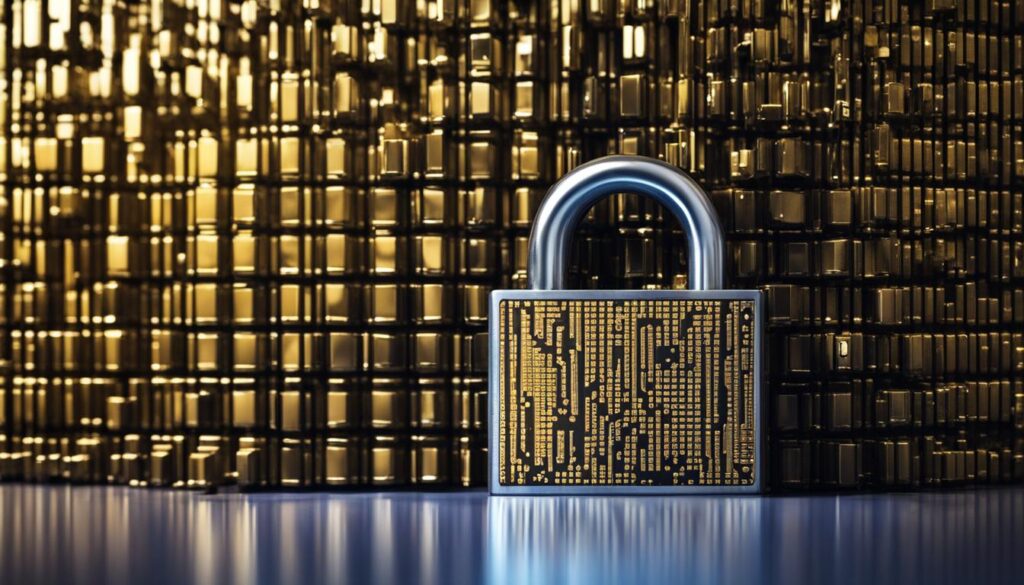As we spend more and more time online, the risk of cybercrime is becoming increasingly prevalent. Falling victim to a scam can not only result in financial loss and identity theft but also cause psychological distress. With Cybersecurity Measures Post-Scam, protecting yourself online has become more critical than ever.
In this article, I will provide you with valuable online security tips to help you keep your digital footprint safe. By implementing these best practices, you can minimize the risk of falling victim to cyber threats and protect your sensitive information online.
Key Takeaways
- Implement cybersecurity measures after a scam to enhance online safety
- Follow recommended internet safety practices to safeguard personal information online
- Ensure secure online transactions with best practices
- Stay informed and proactive to minimize the risk of falling victim to online fraud
- Phishing prevention measures and malware detection and prevention techniques are crucial for Cybersecurity
Strategies to Safeguard Personal Information Online
Protecting your personal information online is crucial to avoid identity theft, fraud, and other cybercrimes. Here are some effective internet safety practices to safeguard your personal information:
- Use strong and unique passwords: Create complex passwords that are difficult to guess and avoid reusing the same password for different accounts. Consider using a password manager to securely store your login credentials.
- Enable two-factor authentication: This adds an extra layer of security by requiring a verification code in addition to the password when accessing an account.
- Avoid oversharing on social media: Think twice before sharing sensitive personal information such as your home address, phone number, or financial details on social media platforms. Cybercriminals can use this information to target their attacks.
- Stay vigilant against phishing scams: Be cautious of unsolicited emails, text messages, or phone calls that request personal or financial information. Verify the authenticity of the sender before sharing any sensitive data.
- Use secure internet connections: When accessing sensitive information such as banking or financial records, make sure you are connected to a secure Wi-Fi network or use a virtual private network (VPN) to encrypt your data and protect against eavesdropping.
- Regularly monitor your accounts: Keep track of your financial accounts and credit reports to quickly detect any unauthorized activity or fraudulent transactions.
By following these internet safety practices, you can help safeguard your personal information online and minimize the risk of falling prey to cybercriminals.
Ensuring Secure Online Transactions
When it comes to online transactions, security should always be a top concern to safeguard your sensitive information from cybercriminals. Here are some important techniques and best practices that you should be aware of to ensure secure online transactions:
- Use secure payment gateways and trusted third-party payment providers.
- Verify that the website is using secure technology, such as SSL or TLS encryption, by looking for the padlock symbol in the web address bar.
- Avoid using public Wi-Fi to conduct any financial transactions as they are often unsecured.
- Be wary of phishing scams that try to mimic legitimate websites or emails to steal your account information.
- Regularly monitor your accounts for any suspicious activity and report any unauthorized transactions immediately to your financial institution or merchant.
By following these practices, you can reduce the risk of your personal and financial information being compromised during online transactions.
To further protect yourself, always keep your software and devices up to date, use strong passwords, and enable two-factor authentication whenever possible.
To learn more about online security, check out our other articles for more tips and insights.

Conclusion
As I conclude this article, it is important to note that cybercrime protection begins with you. By implementing the phishing prevention measures and malware detection and prevention techniques discussed, you can safeguard your digital presence and minimize the risk of falling victim to online fraud.
Remember to think before you click on links or emails from unknown sources, avoid oversharing personal information on social media, and always use strong passwords. Additionally, consider using a reputable antivirus software and regularly update your software and operating system.
By staying informed and proactive, you can significantly reduce the risk of being a victim of cybercrime. Stay safe online, and protect your digital identity.
FAQ
What should I do if I fall victim to a scam?
If you fall victim to a scam, there are several cybersecurity measures you can take to protect yourself. First, report the scam to the appropriate authorities, such as the Federal Trade Commission or your local law enforcement agency. Second, notify your financial institutions and credit bureaus to monitor for any fraudulent activity. Lastly, educate yourself on common scam techniques and implement strong security practices to prevent future scams.
How can I safeguard my personal information online?
To safeguard your personal information online, follow these internet safety practices: use strong, unique passwords for each online account, enable two-factor authentication whenever possible, regularly update your software and devices, be cautious when sharing personal information on social media, and avoid clicking on suspicious links or downloading unknown attachments.
What are some techniques to ensure secure online transactions?
To ensure secure online transactions, consider the following tips: only make transactions on trusted websites with secure payment gateways (look for “https” and a padlock icon in the URL), use secure and encrypted Wi-Fi connections, avoid using public computers for transactions, regularly review your financial statements for any unauthorized charges, and keep your devices and security software up-to-date.
How can I protect myself from phishing and malware?
Protecting yourself from phishing and malware requires diligent practices. Be cautious of unsolicited emails or messages asking for personal information, avoid clicking on suspicious links or downloading attachments from unknown sources, verify the legitimacy of websites before entering sensitive information, and regularly update and run antivirus and anti-malware software on your devices.





